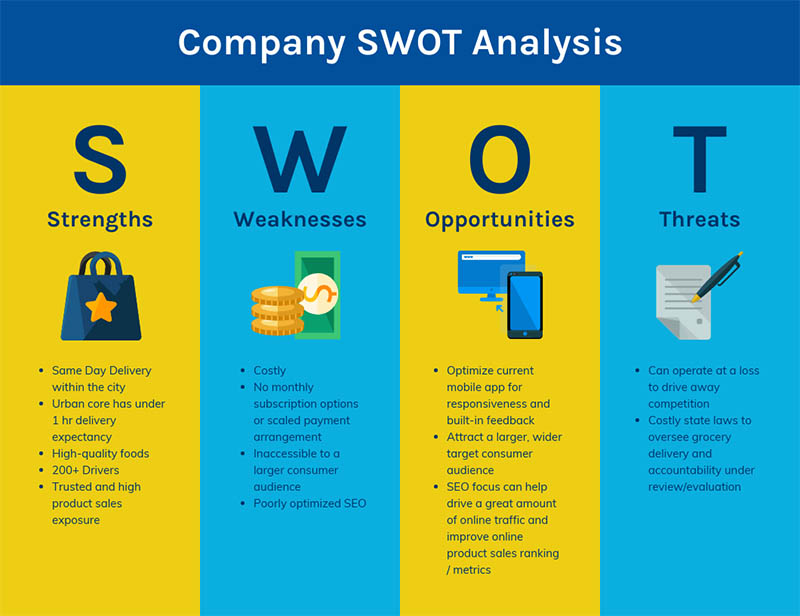SWOT analysis is a methodology to maximize opportunities for business while minimizing negative associated factors. When it comes to unbiased evaluation of your business’s weaknesses and strengths, SWOT analysis comes really handy. It would be evident to mention that running a business is no piece of cake! Right from marketing, sales to management, there are endless aspects that demand your attention.
In order to run a business successfully, it’s of utmost importance for an entrepreneur to think strategically. What happens is strategy planning results in a roadmap for businesses to achieve their goals. While developing a business plan or jumping into a new venture, it’s vital to know the position of the business.
Having deep insights about risks, limitations and capabilities of a business helps you focus more on vulnerable parallels. This is where SWOT analysis chips in. SWOT (Strengths, Weakness, Opportunities & Threats) analysis is used around the world to evaluate a company’s competitive position. The methodology is used to develop strategic planning which involves deep assessment of external factors, internal factors, current potential and future potential associated with a business.

This strategic planning tool helps businesses identify their core strengths and weaknesses, any underlying opportunities, and warn them of threats. When conducted across an organization, a SWOT analysis can help one uncover a plethora of information and insights which can be used in a number of decision-making situations.
How SWOT Analysis Is Done?
No matter the size or age of your organization, SWOT analysis always helps determine the ever-changing internal and external capabilities of any business. It’s like a strategic audit. It serves as a starting point or further high-level discussions. As mentioned-above SWOT analysis technique is used to assess the performance, competition, risk and potential of a business as a whole. The technique can also be extended to specific parts of a business such as product line, a division, an entity, industry or division. SWOT analysis has the potential of providing market-beating insights and results.
It is the findings of SWOT analysis which tells a company where it needs to improve internally and the organization should develop further strategic plans. It is highly likely that SWOT analysis can help in better strategy framing and thus, can lead to success for businesses. Analysts around the world often present a SWOT analysis as a square with four equally-divided quadrants. This visual arrangement offers a quick glance at the company’s Strengths, Weaknesses, Opportunities and Threats. Today, SWOT analysis is not just limited to businesses. It’s often used by governments, individuals, nonprofits, investors, etc.
Strengths:
How a company excels at something and what distinguishes it from its competitors is put under this category. Business strengths give an upper hand when it comes to attracting more consumers. For instance, valuable employees, loyal customer base, amazing brand integrity or strong balance sheet etc.
Weakness:
Whatever stops an enterprise from performing at its full potential or if something hampers the organization to reach its optimum level is put here. This section is very crucial. It involves areas where the business is yet to perform. For instance, high debt, lack of capital, weak brand presence or average turn-over can be a few use cases.
Opportunities:
Apart from how well is your business doing or what challenges you face, there is room for overlooked opportunities too. You’ll always have external opportunities which can boost your business. External factors which can provide an organization with a competitive edge over its competitors are listed here. For instance, if a country lowers tariffs, a manufacturer can export more in the market, thus increased market share and sales can be obtained.
Threats:
These are the listings which hold the potential to harm the business. Threats are out of control of any business. These might arise from fresh or evolving competitors. These might be a lack of demand for a product. It can be a recession too. Lack of consumer spending is also a threat. Other use cases are market decline, unemployment, negative press, etc.

Tips For Conducting SWOT Analysis:
- Create a SWOT analysis template:
One should be prepared before starting a SWOT analysis. Starting with a dedicated SWOT analysis template can be the best possible way to organize information. It will help you prevent missing out on any crucial information. The template can boost the whole SWOT analysis process. Right from your employees to the senior management of your organization, people are going to see it.
- Ask Questions:
For strengths, some of the vital questions to ask can be:
- What are the most positive attributes of the brand?
- What do customers love about the company?
- What competitive edge does a business have over others?
- What’s the unique selling proposition?
For weaknesses, we can use these same principles and ask:
- What customers didn’t like about product/service or company?
- Why do customers return or cancel?
- Negative brand attributes?
- What competitive edge are you missing which your competitor has?
For opportunities, some possible questions you may ask:
- How can customer on-boarding, customer support be improved?
- How to further enhance media presence? For example, social media?
- How to further engage most loyal customers and stakeholders to the company?
- Which advertising medium might exceed the expectations?
For threats, these external and negative factors can be avoided with a contingency plan in place:
- What situations can deter marketing efforts?
- A possible shift in consumer behavior or local regulations that might reduce sales?
- Does the situation threaten the brand’s credibility in the market?
- What possible factors can place business beyond control?
- Study and Take decisions:
Once the SWOT analysis is done, the findings can be used to form and prioritize strategies that can ensure your survival as the fittest. The organization can develop short-term as well as long-term strategies to take the business to the next level while staying away from threats. After all, the true motive of SWOT analysis is to maximize opportunities while minimizing negatives. Brands can make changes in their processes, approaches, and internal hierarchy. In today’s volatile and competitive market, it’s all about seizing opportunities.














Leave a Reply